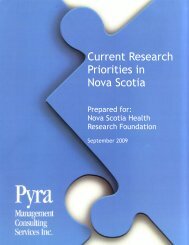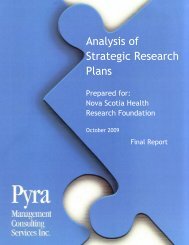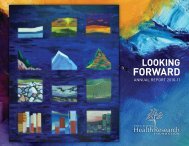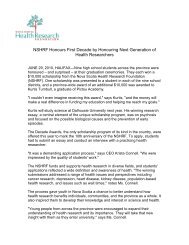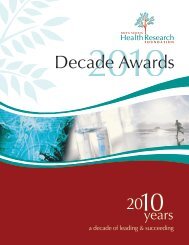Major Health Issues in Nova Scotia: An Environmental Scan
Major Health Issues in Nova Scotia: An Environmental Scan
Major Health Issues in Nova Scotia: An Environmental Scan
Create successful ePaper yourself
Turn your PDF publications into a flip-book with our unique Google optimized e-Paper software.
# Reference Brief Notes<br />
4. Coll<strong>in</strong>s,SK. Employee recruitment: Us<strong>in</strong>g<br />
behavioral assessments as an employee<br />
selection tool. <strong>Health</strong> Care Manag.; 2007;<br />
26(3):213.<br />
The labour shortage of skilled health care professionals cont<strong>in</strong>ues to<br />
make employee recruitment and retention a challenge for health care<br />
managers. Greater accountability is be<strong>in</strong>g placed on health care<br />
managers to reta<strong>in</strong> their employees. The urgency to reta<strong>in</strong> health care<br />
professionals is largely an issue that should be considered dur<strong>in</strong>g the<br />
<strong>in</strong>itial recruitment of potential employees. Behavioural assessments<br />
can be used as a useful employee selection tool to assist managers <strong>in</strong><br />
the appropriate placement and tra<strong>in</strong><strong>in</strong>g of potential new employees.<br />
Although there are vary<strong>in</strong>g organizational concerns to address when<br />
us<strong>in</strong>g behavioural assessments as an employee selection tool, the<br />
5. Cow<strong>in</strong>,L and Jacobsson,D. Address<strong>in</strong>g<br />
Australia's nurs<strong>in</strong>g shortage: Is the gap<br />
widen<strong>in</strong>g between workforce<br />
recommendations and the workplace?<br />
Collegian; 2003; 10(4):20,2, 23-4.<br />
6. Epste<strong>in</strong>,R and S<strong>in</strong>gh,G. Internet recruit<strong>in</strong>g<br />
effectiveness: Evidence from a biomedical<br />
device firm. International Journal of Human<br />
Resources Development and Management; 2003;<br />
3(3):216.<br />
7. Fritsch,K. Situational assessment and<br />
strategies for strengthen<strong>in</strong>g nurs<strong>in</strong>g and<br />
midwifery <strong>in</strong> the Western Pacific region.<br />
Japan J.Nurs.Sci); 2006; 3(1):9,14.<br />
8. Grobler,L, Marais,BJ, Mabunda,SA, et al.<br />
Interventions for <strong>in</strong>creas<strong>in</strong>g the proportion<br />
of health professionals practis<strong>in</strong>g <strong>in</strong> rural and<br />
other underserved areas. Cochrane Database<br />
Syst.Rev.; 2009; (1)(1):CD005314.<br />
9. Jerdee,AL. Recruit<strong>in</strong>g foreign registered<br />
nurses: Chart<strong>in</strong>g the course. J.Nurs.Law);<br />
2004; 9(3):19,28.<br />
potential return on <strong>in</strong>vestment is worth the effort.<br />
The escalat<strong>in</strong>g effect of the current shortage of registered nurses is<br />
be<strong>in</strong>g felt throughout health services from the quality of patient care<br />
through to the closure of beds and hospitals. The follow<strong>in</strong>g<br />
discussion of retention <strong>in</strong> nurs<strong>in</strong>g centres on explor<strong>in</strong>g the effects of<br />
the nurs<strong>in</strong>g shortage from the workplace through to the future of the<br />
nurs<strong>in</strong>g profession. While workplace reform issues such as rais<strong>in</strong>g<br />
nurs<strong>in</strong>g's image, improv<strong>in</strong>g career pathways, provision of quality<br />
mentor and preceptorship, and rais<strong>in</strong>g professional status rema<strong>in</strong><br />
unchanged, the pool of available nurses will cont<strong>in</strong>ue to decrease.<br />
The <strong>in</strong>ternet has become a common source of recruit<strong>in</strong>g, yet no<br />
study, to date, has exam<strong>in</strong>ed its effectiveness. We created several<br />
'ratios' and assessed the effectiveness of <strong>in</strong>ternet recruit<strong>in</strong>g <strong>in</strong> a<br />
biomedical device firm <strong>in</strong> the USA. Our analysis shows the <strong>in</strong>ternet<br />
should not be considered as the end all to the recruit<strong>in</strong>g process. In<br />
order to stay competitive, organisations need to stay abreast of<br />
recruit<strong>in</strong>g trends and strategise their overall recruit<strong>in</strong>g efforts. This<br />
study, <strong>in</strong> conclusion, is a valuable model for assess<strong>in</strong>g <strong>in</strong>ternet<br />
recruit<strong>in</strong>g.<br />
n/a<br />
The <strong>in</strong>equitable distribution of health professionals, with<strong>in</strong> and<br />
between countries, poses an important obstacle to the achievement of<br />
optimal atta<strong>in</strong>able health for all. This study’s objective was to assess<br />
the effectiveness of <strong>in</strong>terventions aimed at <strong>in</strong>creas<strong>in</strong>g the proportion<br />
of health professionals work<strong>in</strong>g <strong>in</strong> rural and other underserved areas.<br />
The authors concluded that there are no studies <strong>in</strong> which bias and<br />
confound<strong>in</strong>g are m<strong>in</strong>imised to support any of the <strong>in</strong>terventions that<br />
have been implemented to address the <strong>in</strong>equitable distribution of<br />
health care professionals. Well-designed studies are needed to<br />
confirm or refute f<strong>in</strong>d<strong>in</strong>gs of various observational studies regard<strong>in</strong>g<br />
educational, f<strong>in</strong>ancial, regulatory and supportive <strong>in</strong>terventions that<br />
may <strong>in</strong>fluence health care professionals' choice to practice <strong>in</strong><br />
underserved areas.<br />
United States health care providers are cont<strong>in</strong>uously challenged to<br />
recruit and reta<strong>in</strong> registered nurses. Despite the many efforts aimed at<br />
address<strong>in</strong>g the nurs<strong>in</strong>g shortage, cont<strong>in</strong>ued difficulty <strong>in</strong> recruit<strong>in</strong>g and<br />
reta<strong>in</strong><strong>in</strong>g registered nurses has led many health care providers to<br />
consider recruit<strong>in</strong>g nurses from other countries. This article provides<br />
an overview of the legal, ethical, and other issues associated with<br />
recruit<strong>in</strong>g a foreign registered nurse, <strong>in</strong>clud<strong>in</strong>g contract<strong>in</strong>g,<br />
immigration, and licensure issues. This article concludes that the<br />
recruitment and employment of foreign registered nurses is a viable<br />
option to address the nurs<strong>in</strong>g shortage, as long as health care



